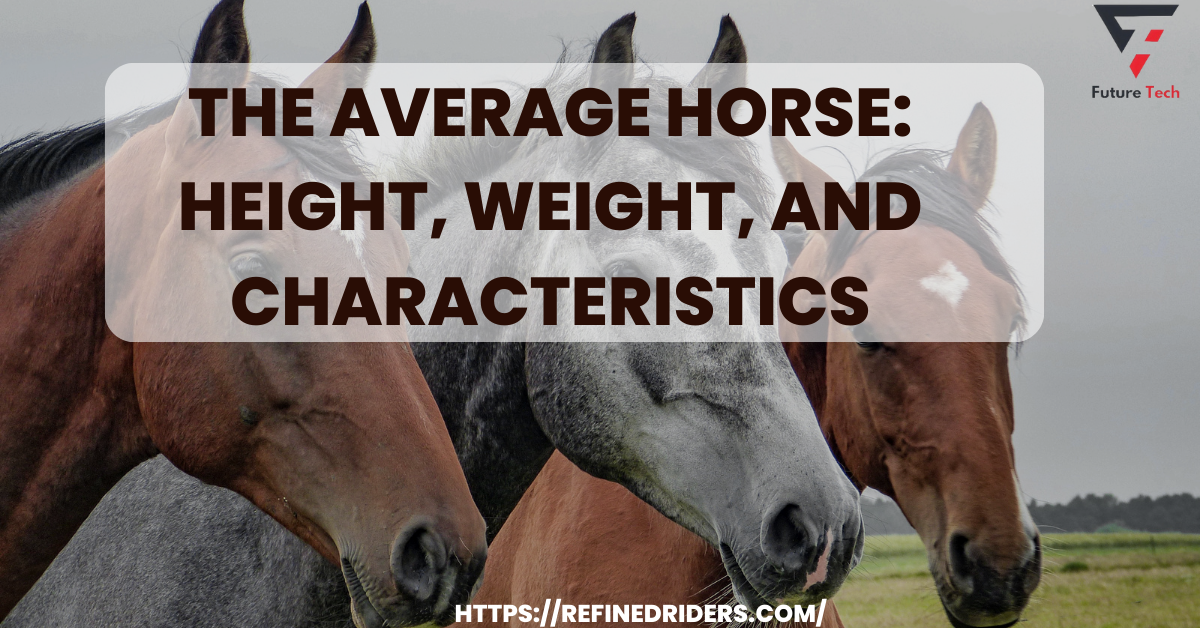I’ll focus on typical horse heights, what they imply, and how to discuss horse heights in writing. How tall is your horse? When do horses usually reach their maximum size? Do they tower over you, or are they just as tall as you? How, in horse language, should we interpret this? In this post, I’ll be speaking specifically about it.
Horses come in various sizes and forms, and you’ll find that their physical characteristics depend on their breed, genetics, nutrition, and level of exercise. Measuring a horse’s height and weight accurately is essential for you as a rider because it will be helpful for various tasks, including determining how much activity they need, sizing up for the correct saddle, and monitoring their nutrition needs.
The size and shape of a horse are separate from any other measurements we would use. Understanding every part of horse measurement is essential to comprehend average horse heights and how they can affect our horses and our riding.
In this article, we’ll go through the basics of calculating a horse’s height and weight, such as:
- How tall are horses typically?
- Factors that Affect Horse Height
- Why do horses have hands?
- How do you measure a horse?
- What is the weight of a horse?
- How should I weigh a horse?
- Weight-control advice for horses
1. How tall are horses typically?
Horses typically stand between 13.3 and 17.3 hands (1.4 and 1.8 meters) tall. All of the breeds that are taken into consideration should be represented in this number. Although some pony breeds can grow taller than this, a pony in the UK is shorter than 14.2 hands (1.47m) for competition reasons. Continue reading this section for more information on the differences between a horse and a pony.

In greater depth, A wide range of heights is visible. Some are, on average, much shorter than others. Larger riding horses are (15.2–17) hands (1.57–1.73m), heavier or draft horses usually are 16–18 hands (1.63–1.83m), and light riding horses are often 14–16 hands (1.4–1.63m). In addition, nutrition and genetics might affect growth.
The most enormous horses in the world are those used for lifting or pulling huge loads, such as the Clydesdale, Shire, Belgian, and Percheron. The tiniest include the Shetland pony, Falabella, and miniature horses, who, for their small size, are pretty solid and resilient.
2. Can you explain the difference between a pony and a horse?
Ponies and horses are both equines, yet perplexingly, a pony can be defined in one of two ways. Regarding biology, ponies are breeds different from horses in that they have longer manes, tails, coats, and additional bone and muscle structures.
On the other hand, a pony (of any breed) competing in UK events cannot be lower than 14.2 hands (1.47 metres), whereas horses must be this tall or higher. Pony horses usually fall into groups for pony riders in competition riding, who ride shorter distances and over smaller jumps. Adults typically compete at the regular levels while riding a horse-class animal. There are larger pony breeds that commonly reach above 14.2 hands, but they should be classified as horses in the competition, which can lead to confusion.
Smaller horse breeds, though technically horses, would participate in the pony division because of their lesser build.
Ponies develop more quickly than horses since they stay little their entire lives. Pony foals will snowball to match their parents in size, whereas horses grow greatly more slowly, with some not reaching full maturity until they are between the ages of five and seven.
3. Factors that Affect Horse Height

Water, lipids, carbs, protein, vitamins, and minerals are the six essential categories of nutrients that horses need to survive.
Horses can’t survive without water for very long; it is the MOST IMPORTANT nutrient! Always ensure that there is a sufficient supply of clean water. For every pound of grass they eat, horses typically drink about two liters of water. Water consumption maybe three to four times higher than usual in hot weather, during physical activity, or for lactating horses. The horse cannot physically take energy. Hence, it is not one of the six nutrients but is still necessary for maintaining life. In all kinds of weather, horses grow. The temperature range in which horses may live is from -40 to 40 degrees Celsius. The nutritional need that affects cold weather the most is energy.
High-quality hay is typically sufficient for free-choice feeding for adult horses in good bodily condition during cold weather. When using poor grasses, grain may need feeding. Heat loss is necessary to keep the body’s core temperature stable in hot conditions (more than 30 degrees C). Horses sweat to cool their bodies. Heat stress can be reduced by giving meals that lower the heat increment. Horses in hot regions may benefit from grain and fat in the diet since they have a lower heat increase than fibrous feeds like hay.
4. Why do horses have hands?
The traditional unit of measurement to measure a horse’s height was a hand, which is still commonly used in many English-speaking nations. Due to history, it is kept in equestrianism as the favored unit of measurement in using both the imperial and metric systems. “H” or “hh” are common names for it. The measure, which has been used since the past, initially relied on handspan, making quite a bit of variation possible depending on the society adopting it. King Henry VIII set 4 inches as the standard measurement in England in 1540, and over the following few hundred years, this practice increased across the rest of the British Empire. The countries still using this 4-inch standard for measurement include the United Kingdom, the United States, Zealand, Australia, Canada, and Ireland. The International Federation for Equestrian Sports (FEI) and other nations primarily use metric units.
5. How do you measure a horse?
To measure a horse, make sure they are standing on a level system and take a measurement upward from the ground to the highest point on their withers (A), as seen in the photo below.
It is better to use a measuring stick marked with hand intervals if you can convert from inches or centimeters. You might also use a tape measure, but you’ll likely need support from someone else to maintain it straight.
You must measure a horse to the highest point of the horse’s shoulders using hand units equal to 4 inches (10 cm). He was the one who fixed the hand at 4 inches (10 cm) in length in 1541, ignoring the fact that it possibly traces back to the ancient Egyptians.
6. What is the weight of a horse?

A horse can weigh anything between 300 and 1,000 kilograms. This measurement will vary significantly among breeds of various sizes, like their height. For example, a racehorse should weigh between 450 and 500 kg, whereas a shire horse should weigh between 700 and 1,200 kg. Ponies are smaller animals that can weigh anything from 180 to 200 kilograms in a Shetland pony to 350 to 450 kilograms in a fall pony. When deciding if a horse’s weight is healthy, one must consider its height because a taller horse would have more bulk due to its larger frame. Age, diet, and exercise level of the horse are further factors. In addition, their genes may impact features like hunger, metabolism, and how much weight they carry.
7. How should I weigh a horse?
Here are the three simplest methods to calculate your horse’s weight with precision:
- Use a horse scale
- Horse weight tape usage
- Using a weighted formula
Please note: We advise taking these measures every one to two weeks and keeping track of your horse’s development. This will allow you to monitor their development and decide whether to adjust their medicine or food. To provide your horse with the best care, you must become familiar with weighing them. This is because if they are over the safe weight range for their breed, major health problems can occur. Being underweight can be a sign of sickness and dental difficulties, while being overweight can lead to laminitis, heart disease, lung disorders, and insulin resistance. By keeping track of their weight, you can ensure their feeding schedule suits their needs and estimate the proper dosage for any drugs they need.
8. weight-control advice for horses

You now know how much your horse should weigh and how to check it. You can keep tabs on its growth every one to two weeks; you might wonder what to do if your horse gains or loses weight unhealthily; you can use our weight chart as an essential guide to a weight range, but if you still need to figure it out, you should assess your horse yourself, you may learn more about judging your horse’s physical condition using our body scoring guide.
Summary:
For excellent horsemanship, it is essential to know the horse’s height. This measurement specifies the specific breed and provides the data to establish the proper meal size and medication dosage. A horse’s average height depends on the species, genetics, diet, and environment. The ability to choose a suitable horse for riding or other activities depends on measuring a horse’s height accurately, which is essential for various reasons.




